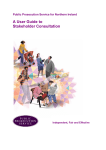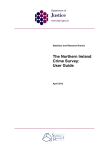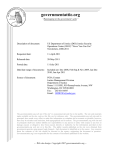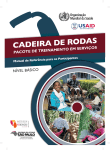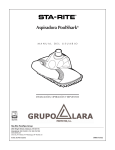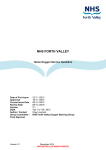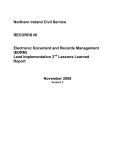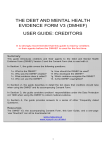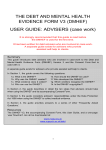Download A USER GUIDE TO STAKEHOLDER CONSULTATION
Transcript
A USER GUIDE TO STAKEHOLDER CONSULTATION Building a fair, just and safer community Alternative Formats This document can be made available in alternative formats, on request. Alternative formats may include Braille, audio formats, large print or minority languages to meet the needs of those for whom English is not their first language. Requests for alternative formats can be made to the Department’s Equality Officer at the address given below: Mark Higgins Equality Officer Department of Justice Block B, Level 3 Castle Buildings Stormont Estate BELFAST BT4 3SG Telephone (028) 9076 5784 E-Mail: [email protected] 2 Contents Page No. Foreword by Nick Perry, Permanent Secretary Introduction Why Consult? Good Practice Guidelines on Consultation Thinking of consulting? What MUST you do? Consultation flowchart Step by Step Guide Consultation Checklist Where Can I get Help? DOJ Press Office Guidance (applies to some 4 5 6 8 9 10 11 21 23 28 criminal justice organisations) Annex A – Examples of Good Consultation Practice Annex B – Further sources of information 29 35 3 FOREWORD by the PERMANENT SECRETARY This User Guide to Stakeholder Consultation has been produced for all staff working in the criminal justice system, including the criminal justice organisations (CJOs). Effective consultation with our stakeholders (who they are, of course, will vary depending on the topic and the area) is crucial: it is one of the most important ways to ensure we get our policies right and secure the confidence of the public we serve. We are working constantly to find ways to do it better. The purpose of this Guide is to help us do just that. It reminds us to plan well and to build sufficient time within the consultation process for early engagement with stakeholders, the Minister and the Justice Committee. It also highlights the importance of engaging with ‘hard to reach’ groups, who are often most affected by the policy in question. It prompts us to consider the most appropriate methods of engaging with a diverse audience and emphasises the importance of cultivating transparent relationships with our stakeholders to help foster public ownership of policies. Sources of advice and support are provided in this guidance, along with examples of good practice. We have worked with a range of stakeholders and staff from right across the criminal justice sector in preparing this guide. I am confident that it will help to ensure that we take full account of our equality responsibilities, and ultimately lead to improved policy outcomes. I hope you find it helpful. NICK PERRY 4 INTRODUCTION This ‘User Guide to Stakeholder Consultation’ is intended to give policy makers throughout the criminal justice system an accessible introduction to the key principles of consultation. Effective engagement does not mean that every consultation must follow the same format or use every consultation tool. You know your policy and stakeholders best – develop a consultation that will meet their needs as well as yours. Each consultation is an opportunity to develop more innovative and effective ways for criminal justice agencies to engage with the community. In “Section 75 of the Northern Ireland Act – a guide for public authorities”, the Equality Commission states: “Section 75 is underpinned by the building of relationships between those who make and deliver public policy and those affected by such policy. Consultation can help authorities to become aware of problems their policies may pose for individuals, which the organisation might not otherwise discover. The legislation requires consultation on the equality scheme itself, on the impact of policies and on matters to which the Section 75 statutory duties are likely to be relevant. Section 75 should enable public authorities to identify the usefulness of their policies with a view to improving service provision and accessibility on a continuous basis. Public authorities will want to ensure that they are providing the best possible services within available public monies. Consultation can help to ensure that public policy meets its intended need and contributes to better service delivery and accessibility. A key aspect of effective consultation is providing timely feedback to consultees demonstrating how their input was considered and how it affected decision making.” Chapter 3 of the Department’s Equality Scheme 2011-2015, http://www.dojni.gov.uk/index/publications/publication-categories/pubs-departmentalbusiness/doj-equality-scheme-2011-15.htm sets out the Department of Justice arrangements and commitments for consulting in accordance with the Equality Commission’s guidance. 5 WHY CONSULT? There are three very good reasons why we should consult with the public. It is good practice, it makes for better policies and services and it makes sense to ask those directly affected for their views. When you are preparing a consultation you should look to and beyond the generic groups that respond routinely to public consultations. Also keep in mind that Section 75 emphasises the need to actively seek ways to encourage greater equality of opportunity and good relations through policy development. Our Equality Schemes recognise the importance of consultation in all aspects of the implementation of Section 75 statutory equality duties. Based on the feedback provided during the research for this guidance, it is clear that some stakeholders believe that not enough thought goes into reaching those affected by the matter under consideration. It has also been raised that engagement should be more meaningful – a two way process – and we need to demonstrate that we take full account of stakeholders’ views. The Criminal Justice Inspection NI’s 2009 report revealed that a number of groups consulted had acknowledged the failure of the early approach to consultation which was described, by the Equality Commission, as “general mailshots with no targeting and no follow-up”. It was agreed that this approach was not always appropriate and that more focused and targeted consultation was necessary. Concerns were raised, however, that some of the agencies, when faced with the low response rates to the earlier attempts at general consultation, had decided on a policy of “targeted but selective” consultation. The consulted groups felt that this often had the outcome of excluding some of the voices which might be most critical of the approach being taken by the criminal justice agency involved. It must, therefore, be stressed that consulting is about dealing holistically with equality of opportunity across a range of categories. Every consultation must be approached on the basis of its specific content. Although certain minimum standards must be met in every one, the most effective means of consultation can only be decided on the basis of the details of the policy in question. 6 A Criminal Justice Consultative Forum, encompassing Section 75 Representative Groups, has been established to support and improve the way in which criminal justice agencies conduct consultations. In the longer term, it is envisaged that the Consultative Forum will engage with the Criminal Justice Board to provide advice and raise issues of strategic significance. 7 Good Practice Guidelines on Consultation These guidelines have been developed around a framework comprising seven key criteria: Criterion 1: Planning for consultation: Staff should have an awareness of section 75 and Human Rights responsibilities and the skills and resources necessary to undertake the consultation. Identify where training is needed. Also, look beyond specific section 75 groupings and consider that ‘multiple identity’ groups (i.e. those who fall into more than one category) may be affected. Criterion 2: Timing and duration of consultation: Early engagement with stakeholders is vital! This can mean initiating engagement months before launch of a formal consultation document. Consultation should begin when there is an opportunity to influence the policy outcome e.g. the early pre-development stage on policy proposals. The main policy consultations should normally last for at least 12 weeks with consideration given to longer timescales where feasible and sensible. A consultation may last for less than 12 weeks but under exceptional circumstances only and when agreed at Grade 5 level with Deputy Director of Central Coordination Directorate. Guidance is available on page 38 of the Equality Commission publication “A Guide for Public Authorities” via the following link: http://dojnet/s75guideforpublicauthoritiesapril2010_1_.pdf or contact your departmental equality advisers Criterion 3: Clarity of scope and impact: Consultation documents should be clear about the process, what is being proposed, the scope to influence and the expected costs outcomes (where available). Criterion 4: Accessibility of consultation exercises: Consultations do not always take the form of a ‘published’ paper and you should target your audience by engaging with key stakeholders to establish appropriate methods of communication. Criterion 5: Recognising the resource impact on consultees: Seek to minimise the burden on those being consulted whilst striking a balance to ensure you reach the relevant groups affected by your policy. Plan well in advance and give stakeholders sufficient advance notice of your intention to consult. Criterion 6: Feedback /Responsiveness of consultation exercises: Responses should be analysed carefully and clear feedback provided following the consultation. A summary report must be published – advice can be obtained from your departmental Equality representative. Criterion 7: Sharing experience and monitoring: Draw on the experience of others in delivering an effective consultation outcome, network effectively and share what you have learned with colleagues and external stakeholders. Your Equality Officer should provide advice on the appropriate forum to do this. Ensure that you monitor and evaluate your results to draw upon lessons learned. 8 Thinking of Consulting? What MUST you do? First, decide whether a consultation is required.. ensure you plan well and allow sufficient time for an early discussion with Special Advisor and Minister at the outset of policy development; ensure early engagement with stakeholders; where applicable, early engagement with the Committee for Justice, through DALO, either to inform or to seek views; talk to colleagues and learn from experience; screening your policy early and share with consultees as part of the screening report, ensuring the screening form is attached as an Annex to the consultation document; use plain English, explain technical terms and jargon; include reference to Section 75 duties and Human Rights obligations in the document; advise entire distribution list of forthcoming consultation, inviting interest (update list regularly); and produce and publish Summary reports of consultation responses following analysis. 9 Consultation Flowchart What is the consultation about? What will the consultation achieve? Identification of timescales and questions for consultation What is the scope of the consultation? How long will it last? Consider how responses will be evaluated, and be clear about what feedback you require: avoid asking ‘leading’ questions BEFORE Subject and purpose of consultation Identification of stakeholders and methods DURING Decision to proceed Publication and distribution of material Consultation period: 12 weeks (at least) (Less than 12 weeks in exceptional cases only with SCS clearance and documented reasons for doing so). AFTER Analysis of responses and dissemination of results Review of consultation process Who should be consulted? What is the best way of reaching them? Consider engaging someone in the role of a ‘critical friend’ for feedback on your document You need to be aware of how to reach your audience Have you considered legal and Human Rights obligations? Have you chosen all methods to reach everybody? Where practical include links to relevant documents in consultation documents Test whether the material is accessible Do stakeholders have enough time to respond? Will submissions be published? Will the analysis draw out key messages and themes? How will feedback be given? Will you need help to analyse? Will another consultation be required? What worked and did not work in the consultation (ask consultees)? How will lessons be disseminated? Did the consultation make a difference? Ensure you seek feedback 10 Step by Step Guidance on Stakeholder Consultation The following table sets out a step by step guide on the different stages of consultation, from pre-consultation to analysis and publication. While each consultation will have its own particular stakeholders and differing ways of engaging, the general principles below will help you carry out a proportionate and effective consultation. 1. Agree on subject and purpose of consultation: Questions to ask….. Why are you consulting? Are you and your team clear about what you are consulting on? Are your plans, timescales and milestones clear? What outcome / objective do you need to achieve? Have you considered seeking the support and engagement of other criminal justice agencies? What resources will be required, including staffing? Have you and your staff taken up training opportunities on ‘Public Consultation and Engagement’? Points to consider…. The pre consultation period should not be rushed. It is important to take time to plan prior to consulting, and, if applicable, to prepare a detailed project plan. Consider how you are going to encourage stakeholders to become involved and plan the process from ‘who to consult with’ to agreeing on how you will analyse findings, monitor, evaluate and provide feedback to your consultees. Early engagement with your key criminal justice partners makes sense, helping identify any potential problems at the outset. Have you developed a working relationship with criminal justice partners? The Centre for Applied Learning (CAL) offers a one day course entitled ‘Public Consultation and Engagement’, which provides invaluable advice and a useful opportunity to discuss with other civil servants, who are at various stages of engagement. 11 2. Identify timescales for consultation: Is your team aware of section 75 Statutory responsibilities? How long should the consultation last? How will you consult? Equality screening takes place. Your organisation’s equality experts can advise – equality screening must be shared with consultees. Definition of an Equality Impact Assessment (EQIA) “The mechanism underpinning Section 75, is a form of assessment to find out how a policy may discriminate against a group of people, and to identify how to mitigate against these factors. EQIAs require the analysis of both quantitative and qualitative data.” Consider that your policy may require Rural proofing ‐ Shared Future, Economic and Social proofing, as well as Equality of Opportunity guidance – available on the Intranet or contact your Equality Officer Formally, at least 12 weeks and following a period of early engagement with key stakeholders. You MUST allow longer if the consultation coincides with a holiday period – less than 12 weeks consultation may be agreed at SCS level with Head of CCD in exceptional cases only. [i.e. in cases where EU legislation requirements may mean a shorter consultation period] Consider – proportionately – whether ‘road shows’ are going to be appropriate, consider interactive tools, how you will reach all diverse groups. Consider the impact of the issue, is it wide ranging or more specialised? You should decide how best to reach your audience after considering these factors. 12 3. Identify stakeholders: Who are your stakeholders? Do you know who your stakeholder ‘Umbrella’ groups are? How and when should you engage? Have you considered consulting with your own staff? Have you considered whether similar work is ongoing elsewhere, internally and beyond the Department? Make use of existing Networks and current Best Practice being applied constantly across the Department. (see Annex for ’helpful contact’ details). Ask S75 representative groups for advice in reaching and engaging with stakeholders As early as possible – remember that your stakeholders also have a relationship with the Executive and Justice Committee, and earlier engagement keeps the right people informed of your plans and presents an opportunity to influence the policy at an early stage. Carry out a stakeholder analysis. Remember that Public Sector Organisations should be representative of the community – and that their views are important! Internal Staff Diversity Groups can provide highly valuable feedback to your proposals. . For example, the Diversity Networks provide a source of expertise and best practice to all business areas and are a useful sounding board for diversity and equality issues. Representatives from across the DOJ family sit on these networks and meet 3 to 4 times per year. Further details are available in the "Where can I get help" section at page 27. It is highly valuable to liaise with other business areas and experts in the field to establish if similar policy/work is ongoing elsewhere in the department and organisation. Consider whether there is value in collaborating with partners to achieve maximum buy‐in from stakeholders. 13 What are the best ways of reaching stakeholders? Who can help you to reach the marginalised groups? Do you ask your stakeholders regularly if they wish to remain on your consultation list? Remember that your stakeholders also have stakeholders! You may have not had an opportunity to develop a relationship with these bodies ‐ and often these are the groups who are overlooked and who could potentially make a significant contribution to policy development – find out who they are and how to reach them. Contact your organisation’s Equality adviser to identify key stakeholders with whom you should initiate early engagement. Much value can be added to the process by pre consulting with these important stakeholders. Contact the Equality Commission, if you need advice and validation of your approach from them. www.equalityni.org 14 4. Decision to proceed: Have you sought appropriate approval on the policy intention and consultation process? Have you drafted a discussion paper and draft consultation document'? When should you write to the Executive? Your Chief Executive, Director or the Justice Minister, as appropriate should be informed and involved at the earliest opportunity. Applicable to DoJ staff and affiliated bodies. 'The Minister should have already provided approval to the policy intention before seeking approval to proceed to consultation and on the draft consultation document. The DALO can advise on the role of the Committee. The draft discussion paper/consultation paper should be agreed by officials and the Minister and issued, via the Minister, to the Justice Committee for its views prior to publication. There may be a need to involve the Executive if your policy is cross cutting. The submission to the Minister, attaching the draft Justice Committee paper and draft consultation paper, should be with the Minister no later than two weeks before the pre‐scheduled Justice Committee date for consideration. Officials should engage with the DALO to arrange a scheduled Justice Committee date well in advance of when this is needed. Consult your in‐house experts for advice on how you should initially announce the forthcoming consultation. A targeted approach should then be taken to consulting with those who express a particular interest in the policy area. Consider your audience – and various accessible formats. 15 5. Identify methods: Are you considering advertising? or Have you considered asking stakeholders to advertise for you, through their websites? How can you ensure your chosen methods reach everybody? How will you launch the Consultation? Involve your media advisers at an early stage to discuss how to put the consultation into the public domain. If you need to advertise, where and how much will it cost are all issues your media unit can advise on. It will also provide advice on the press release, any specific publications and the use of social media. Consider whether you should advertise in relevant specialist, press or media. The consultation document will have to be placed on the website and must comply with accessibility guidelines. Your website team will be able to advise you on how this is achieved. As this is not the only medium, consider other ways that will help you to contact the hard to reach groups. Consideration is being given to the use of social media as a consultation tool. Many stakeholders, agencies and partners regularly use social media, such as Twitter and Facebook to communicate with stakeholders – consider asking your partners to announce on your behalf. Use your website to announce your consultation, and consider using criminal justice partners’ websites to gain maximum exposure. Consideration should be given to launching the consultation at an appropriate event, hosted by the Minister – take advice from your Media advisers 16 CONSULTATION PERIOD ‐ duration of at least twelve weeks, giving consideration to holiday periods! During consultation period – questions to ask…. 6. Publication and distribution of material: Have you chosen communication channels to reach everybody? Consider your audience and whether other formats are needed. Offer a translated version of the document. Have you provided the option to respond in a number of ways? And is the material accessible? Documents should be provided in accessible language appropriate to your audience. The Equality Commission’s website provides advice www.equalityni.org Provide clear instructions for responding to your consultation and offer flexibility on how to respond. The Participation Network provides advice and consultancy support to Government agencies wishing to engage with children and young people – this includes drafting young person friendly versions of documents. www.participationnetwork.org You may consider using a citizens' jury when you have a 'live' contentious issue where the way forward has not been decided or where workable policy options have been developed by policy makers. Seek advice from your departmental Equality representative. Consider how to reach all marginalised groups. For advice on this contact the Equality Commission or an umbrella group, such as Northern Ireland Council for Voluntary Action (NICVA) In contentious cases, can you consider using a “Citizens’ Jury”? Have you considered focus groups, workshops, public meetings? 17 Do stakeholders have enough time to respond? A sensible method of reaching your stakeholders is to ‘piggy back’ by going along to partners’ meetings and forums during the consultation period. Ensure there is flexibility in dates for response If necessary and appropriate, consider extending the deadline and advise consultees accordingly. Post consultation period – questions to ask…. 7. Analysis of responses and dissemination of results: How can you encourage/remind stakeholders to provide feedback? Will respondents’ submissions be published? Will the analysis draw out key messages and themes? Are you content that your questions are phrased in a meaningful way? Is ‘specialist’ help needed for the analysis? Contact (Email or phone) consultees to remind of deadline; Follow up with targeted phone calls to consultees. You should advise consultees of your intention to publish at the earliest opportunity. Consideration should have been given to this by crafting questions that should be easily understood. Formal analysis is crucial to assess whether the policy meets the intended objective, and this should be qualitative and quantitative. Statisticians? Economists? 18 Post consultation period – questions to ask…. How will feedback be given? Do you need to weight responses? Are you content that you have been open about how you weight responses? Can your audience access the completed document and published policy? Can you demonstrate to respondents that their input was valued and considered fully? What is the process for informing the Minister and the Justice Committee of consultation responses? How will the Justice Committee be advised of the completed consultation? Produce your analysis in a format that is easily understood. Some groups may have greater experience or understanding of the issue than others. However, you need to consider how to weight the responses received. Specify those issues that are accepted, rejected and noted and reasons for same. For advice on weighting of responses, contact your departmental Equality adviser Consider how, when and where you will publish. Think of how your final document will demonstrate to respondents that you have considered their input. Thank respondents for their input Speak to the Departmental Assembly Liaison Officer (DALO) well in advance – prepare a submission to DALO and the Minister. Ensure you have allowed sufficient time for publishing your final document. You need to return to the Justice Committee, prior to publication for its views, with a list of who responded, a breakdown of who said what and summary of responses/themes arising and any changes to your policy. 19 Post consultation period – questions to ask…. How is the decision going to be shared? What is the mechanism? 8. Review of consultation process: Have you evaluated your consultation? How will you consider the ‘Lessons learned’ during the process? Officials will need to prepare an oral or written briefing for the Committee. DALO will provide advice on forthcoming Committee Business. Hold an early wash‐up meeting to reflect on lessons learned. What worked and did not in the consultation? Important to evaluate whether the consultation made a difference. 20 Consultation Checklist A consultation must always have clear aims and objectives. Consultation should be about engaging with practitioners and the community to improve your proposals, and to seek views on what will work. Follow these simple rules and you can’t go wrong. 1. When you decide to consult, ask for advice The Department and agencies have launched many consultations and your colleagues have been through it all before. Ask them for the pitfalls, what worked well and what they would do next time around. Contact your experts. Help is out there! Make use of networks: find out if similar consultations are ongoing or due to launch 2. Screen early – Section 75 is vital to the consultation Although pre-consultation with key stakeholders will add time to the process it is a key part of effective consultation. A few extra weeks of meaningful engagement at this stage will add value to what you produce and may save you time in the long run 3. Factor in extra time for the committee The Justice Committee has a key role in scrutinising a draft consultation document before it is formally launched and the consultation responses after analysis and prior to publication– it’s their job! It is always a good idea to talk to the Departmental Assembly Liaison Officer (DALO) to discuss when and how to involve the Committee. 4. Pre-consultation with those most closely affected is always a good idea 5. Involve your media experts at an early stage 21 6. Involve a critical friend Before issuing your document ask colleagues in the Department to run a critical eye over your proposals 7. Be clear on why you are consulting and be proportionate Case Study: A County Council in England sent out a 20 page survey to 180,000 homes at a cost of £100,000. The survey took two hours to complete and was returned by 85 people – that’s £1,200 per response. 8. Be flexible, avoid consultation overload and expect some negative views – it’s not personal! 9. Use plain English – avoid jargon and try to make your consultation interesting 10. Avoid leading questions 11. Allow at least 12 weeks for formal response – longer if it clashes with holidays 12. Offer a choice of ways to respond – it’s about the consultee, not what’s easy for the Department! 13. Actively involve ‘hard to reach’ groups Become familiar with the many ‘umbrella’ organisations out there 14. Consider carefully how you will publish responses After you have analysed responses you must produce a summary report. Consideration should be given to publishing all responses, where appropriate. 22 Where Can I get Help? [For completion by Criminal Justice Agency equality representatives] ISSUE CONTACT DETAILS/RELEVANT LINK Consultation Mark Higgins http://dojnet/index/aboutdoj/equality-home.htm or contact Mark direct for advice Advice Central Management Unit Room B3.13b Castle Buildings Stormont Estate BELFAST BT4 3SG Tel: 028 9076 5784 [email protected] Equality- Mark Higgins Section 75 of the Northern Ireland Act (1998) – A Guide for Public Authorities Screening Central Management Unit (Revised April 2010) http://dojnet/s75guideforpublicauthoritiesapril2010_1_.pdf and EQIAs Room B3.13b DOJ Screening Form http://dojnet/doj_equality_screening_form-7.doc Castle Buildings Stormont Estate Equality Scheme 2011-15 – A Quick Guide for Staff BELFAST BT4 3SG http://dojnet/equality_scheme_2011-15__a_quick_guide_for_staff_protected- Tel: 028 9076 5784 2.doc [email protected] Guidance on Equality Impact Assessments http://dojnet/ecni_eqia_guidance_body_text_20030926-2.pdf 23 ISSUE CONTACT DETAILS/RELEVANT LINK Departmental Barbara McAtamney Guidance on distribution of consultation documents Assembly Minister’s Office Liaison 5th Floor Officer Castle Buildings (DALO) Stormont Estate http://dojnet/guidance_on_distribution_of_departmental_publications_and_consu ltation_documents_-_dec_2012.doc BELFAST BT4 3SG Tel: 028 9052 2624 [email protected] Shared Mark Higgins Future Policy Central Management Unit Proofing Room B3.13b Shared Future Policy Proofing Grid Template http://dojnet/shared_future_policy_proofing_grid_template-2.doc Castle Buildings Stormont Estate BELFAST BT4 3SG Tel: 028 9076 5784 [email protected] 24 ISSUE CONTACT DETAILS/RELEVANT LINK Rural Mark Higgins The Essential Guide to Rural Proofing Proofing Central Management Unit http://dojnet/the_essential_guide_to_rural_proofing_pdf.pdf Room B3.13b Castle Buildings Stormont Estate BELFAST BT4 3SG Tel: 028 9076 5784 [email protected] Advertising Jenny Magill DOJ Press Office Castle Buildings Stormont Estate BELFAST BT4 3SG Tel: 028 9052 6139 [email protected] 25 ISSUE CONTACT Press Office/ Diarmuid McLaughlin Website DOJ Press Office DETAILS/RELEVANT LINK Castle Buildings Stormont Estate BELFAST BT4 3SG Tel: 028 9052 6442 [email protected] Email Karen Dalzell distribution/ Central Management Unit Consultation Room B3.13b list Castle Buildings DOJ Consultee List http://dojnet/index/aboutdoj/equality-home.htm Distribution Lists available on request. Stormont Estate BELFAST BT4 3SG Tel: 028 9052 8231 [email protected] 26 ISSUE CONTACT DETAILS/RELEVANT LINK Consulting Roy Warner The four staff networks include : with DOJ Learning & Development Unit Lesbian, Gay, Bisexual, Transgender (LGBT) Network; Knockview Buildings Black Ethnic Minority Network (BEMLINK); Stormont Estate Disability Forum; and Carers Forum. Staff Diversity Networks BELFAST BT4 3SG Tel: 028 9052 3177 [email protected] 27 DoJ Press Office Guidance for placing consultation documents on DoJ Website The web team must be given at least three working days notice of any documents to be placed on the website, which must be provided in MS word format and officials should carry out the following steps prior to sending the MS Word document to the web team (to ensure accessibility compliance) Acknowledge needs of people with disabilities from the outset: Arial font 14 and offer other means of access to the document Open the Word file whose metadata you want to view. Now click on the "File" pull-down menu in the menu bar and choose "Properties." If you do not see the "Properties" option, look down to the very bottom of the current menu column. Find the double downward-pointing arrow and click it to reveal more choices. After you've clicked the "Properties" option, various metadata will appear - tabs for Summary, Statistics, Contents and Custom. Fill in as many of these as you can (particularly on the summary tab), but do not enter an official's name as the author. Ensure any links in the MS Word document are 'live' and have been checked, otherwise it will be returned to you. Each consultation will have its own specific page on the website and the page will include a summary paragraph. This summary should be provided to the web team, along with the associated documents, see e.g. below: http://www.dojni.gov.uk/consultation-on-encouraging-earlier-guilty-pleas.htm 28 Annex A Examples of Good Practice Index 1. Good practice example of staff training 2. Timing: consideration given to when to launch a consultation 3. The importance of pre consulting 4. The value of ‘piggy backing’ to your stakeholders’ meetings: example of how early engagement builds relationships 5. Example of how the Screening process has resulted in a positive impact on a group 6. The positive impact achieved by convening workshops 7. Making best use of partners to reach groups and producing accessible material 8. Drawing on the experience of others 9. Collaboration of Criminal Justice agencies to reduce the burden on consultees 10. Ensure meetings make effective use of time 11. Provide clear feedback to consultees 29 1). Good practice example of staff training: The Northern Ireland Legal Services Commission has ensured that all staff have received training on the Section 75 obligations and responsibilities and this is incorporated into job descriptions and not only for those staff in Policy team who are specifically engaged in the planning and consultation process. Staff who are screening policies have received specific training on screening and best practice. 2). Timing: consideration given to when to launch a consultation: Consultation periods have been extended as necessary (increased from 12 to 14 weeks) as they coincided with public holidays; e.g. consultations on the DOJ Equality Scheme; Measures to encourage Earlier Guilty Pleas, Committal Reform, and the ‘Minister’s Long Term Policing Objectives’. Extending consultation periods in this way is considered Best Practice to ensure everyone is given sufficient time to respond. 3). The importance of pre consulting: Organisations involved in the pre-consultation on the Community Safety Strategy were made aware of the consultation in advance of the launch date. The local consultation meetings were tailored to the needs and specific interests of the groups and the public engagement events were facilitated by CSU officials in order to communicate effectively with consultees and to ensure full participation in the meetings held. 4) The value of ‘piggy backing’ to your stakeholders’ meetings: example of how early engagement builds relationships; During the pre-consultation period, Protection & Organised Crime Division attended a partner’s meeting to use the opportunity to highlight their forthcoming consultation; to provide details on where the document would be available; to 30 provide contact details and to gather contact details for distribution of the consultation. Another partner organisation held a seminar attended by licensing officers from all the local councils, PSNI and legal representatives. Those involved in the consultation attended the meeting, held a presentation to outline the consultation and encourage all present to respond or attend one of the specific stakeholder engagement events. ‘Piggy backing’ on these meetings helped reduce the Department’s consultation costs and provided another method of obtaining the views of stakeholders. 5) Example of how the Screening process has resulted in a positive impact on a group: A short paper was issued for consultation on a proposal to amend procedures in the Magistrates' Courts Rules to increase the use of service of summonses by post. Officials recognised that these particular changes might be of wider interest, and recommended that NICTS issue a 'targeted consultation' to the main criminal justice participants and stakeholders. The decision was taken to alert all the bodies on the NICTS 'general' consultation list to make them aware of the exercise, and invite them to participate if they felt that it was of relevance to them - rather than automatically include all of them from the outset (essentially to address the consultation fatigue argument.) The equality screening of the policy was valuable in refining the approach to the consultation. The screening panel identified that persons from different racial groups, persons with a disability and young people might have different needs in relation to the policy. Although the panel determined that the policy had sufficient safeguards to ameliorate any impact on these groups, the panel recommended that a number of additional groups be added to the list of 'targeted' consultees. Meetings were offered with stakeholders during the consultation period to discuss any emerging issues. Women's Aid raised a concern about serving summonses by 31 post in cases of domestic violence, and a meeting with PSNI and PPS was held to discuss this and, as a result, PSNI and PPS agreed to draft and implement a protocol dealing with circumstances in which postal service might not be appropriate in individual cases. Women's Aid, in particular, was very complimentary about how the consultation had been conducted. 6). The positive impact achieved by convening workshops: (a) DOJ Consultation January 2012: “Encouraging Earlier Guilty Pleas” This consultation sought views on the Department’s ideas for encouraging people who are guilty of a criminal offence to admit their guilt at an early stage, to reduce the burden on victims and witnesses, as well as increasing awareness of the scheme. As part of the consultation process, DOJ officials convened a series of workshops with groups representing victims’ interests to better understand the impact of delay on victims. In the course of those discussions many examples were put forward which illustrated how anxieties about the criminal trial itself added to the distress for victims. This feedback, together with findings from a recent Victims and Witness Survey led to important information about victims’ concerns being taken into consideration. Offenders were also consulted during this consultation. (b) Discussing developments with stakeholders throughout the policy making process; The Speeding up Justice Programme holds regular stakeholder sessions to provide briefings on developments in the programme and to address any concerns raised by stakeholders. This form of open debate provides an opportunity to build upon relationships with stakeholders, increasing transparency and confidence in the department. This continuous process of engagement has delivered a number of benefits in terms of developing policy, legislation and better procedures. It also gives representatives from a range of sectors an opportunity to discuss relevant issues. 32 7) Making best use of partners to reach groups and producing accessible material: In developing the Community Safety Strategy consultation paper, the Department of Justice followed the Equality Commission for Northern Ireland’s revised Section 75 guidance “A Guide for Public Authorities” published in April 2010, as well as the relevant Departmental guidance. The Department worked with Participation Network to develop a child friendly version of the consultation paper which was circulated to its members requesting to engage with children and young people to determine their views on the best ways to address community safety issues. In another example of reaching stakeholders, the NSPCC assisted the Department by drawing together a focus group of young witnesses to discuss the draft “Code of Practice for Victims of Crime”, and as a result of the feedback given by this group, a number of changes were made. 8) Drawing on the experience of others: Community Safety Unit were proactive in disseminating their consultation document by drawing on the experience of officials within OFMDFM and DENI on recent consultations they had undertaken and making use of their consultee lists in order to reach a diverse audience and to alert potential consultees to the consultation exercise. The consultation paper was made available both in hard copy and electronically and the Department worked with Participation Network to develop a child friendly version of the consultation paper which was circulated to the members of Participation Network to gather views specifically from this sector on the proposals. This was also made available on the Department’s website. 9) Collaboration of Criminal Justice agencies to reduce the burden of consultation: Two new disability duties were added to the Disability Discrimination Act 1995 which required public authorities to submit a Disability Action Plan to the Equality 33 Commission (EC). Conscious of the short turnaround time and the consequent burden on consultees, several of the criminal justice organisations collaborated on a public consultation exercise. 10) Making optimal use of meeting time to reduce the burden: In order to further minimise the burden of those being consulted, Community Safety Unit used existing meetings and forums where possible, with the Community Safety Strategy consultation included as an agenda item where appropriate. The consultation paper included at the beginning an introductory summary describing the purpose and key aspects of the consultation 11) Provision of clear feedback to consultees: a) The consultation on the Department’s Disability Action Plan 2011 – 2015 included meetings and a workshop for key stakeholders who were provided with feedback from those events. In addition, the Department published a summary of the recommendations from consultees that had been accepted, partly accepted and noted. The report provided comments which explained the reasons for those recommendations that were partly accepted. b) The Community Safety Unit acknowledged all responses to the Community Safety Strategy upon receipt. All responses, both written responses and those views received through the local consultation events and public meetings, were analysed. Respondents were sent a copy of the summary of responses to the consultation when published and copies of the written responses received to consultation were made available on the Departments website except in those cases where respondents withheld consent. 34 Annex B Further Sources for Information DOJ Intranet http://dojnet/index/aboutdoj/equality-home.htm and DOJ Internet http://www.dojni.gov.uk Northern Ireland: Equality Commission Northern Ireland: www.equalityni.org Section 75 of the Northern Ireland Act 1998 – A Guide for Public Authorities. (Revised 2010) Equality Commission Northern Ireland - consultation advice http://www.equalityni.org/sections/default.asp?cms=policy_Section+75++the+statutory+duties_consultation&cmsid=89_98_102&id=102&secid=6 Equality Commission Northern Ireland www.equalityni.org Monitoring Implementation (public policy and programmes) of the United Nations Convention on the Rights of Persons with Disabilities (UNCRPD) in Northern Ireland Equality Commission Northern Ireland (2008): www.equalityni.org Lets Talk Lets Listen: Guidance for public authorities on consulting and involving children and young people. Office of First and Deputy First Minister A Practical Guide to Policy making in Northern Ireland www.ofmdfmni.gov.uk/policylink-a-practical-guide-to-policy-making DHSSPS 2003 Guide to Consultation Methods for Northern Ireland Public Authorities www.dhsspsni.gov.uk/consultationguidance 35 Office of First and Deputy First Minister (2003) Effective Policy Making Workbook Five: From Consultation to Announcement Office of First and Deputy First Minister (November 2008) Guidance on distribution of Departmental publications and consultation documents NI Direct for information, help and advice on equality matters delivered through the official government website for Northern Ireland citizens: http://www.nidirect.gov.uk/section-75.htm Northern Ireland Commissioner for Children and Young People (NICCY): Participation Policy Statement of Intent. Office of First and Deputy First Minister website for information, help and advice on equality matters: http://www.ofmdfmni.gov.uk/equality.htm Great Britain: Cabinet Office (2002) Viewfinder: A Policy Maker’s Guide to Public Involvement. Department for Business, Enterprise and Regulatory Reform (2008): Code of Practice on Consultation. Dundee City Council: An introductory guide ‘How to consult your users’. Scottish Executive (2002): Good Practice Guidance: Consulting with Equality Groups. Scottish Executive (2008): Consultation Good Practice Guidance. Republic of Ireland: Department of the Taoiseach (2005) Reaching Out Guidelines on consultation for Public Sector Bodies 36




































